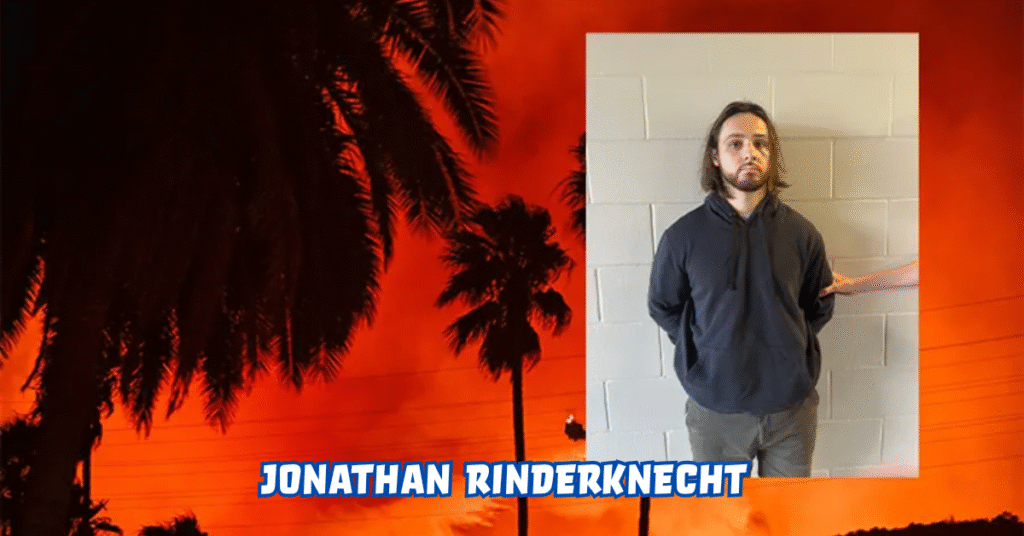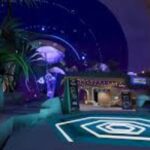A man was arrested today in connection with one of the deadliest wildfires to hit Los Angeles this year: the Palisades Fire. That man is Jonathan Rinderknecht, 29, now facing federal charges for “destruction of property by means of fire.” In the first 100 words, here’s what you should know: prosecutors allege that Rinderknecht intentionally started a brush fire on January 1, 2025, in the Pacific Palisades region, which smoldered underground and then reignited days later, morphing into the catastrophic Palisades conflagration that claimed 12 lives and destroyed thousands of structures. His arrest follows a nine-month investigation involving digital evidence, geolocation data, witness statements, and surprising AI artifacts.
What follows is an in-depth, up-to-date account of Rinderknecht’s alleged role, the evidence against him, his background, the legal implications, and how the fire evolved from a small ignition to a regional disaster. We also explore gaps in the investigation, unanswered questions, and public reaction.
The Fire: From Lachman to Palisades — The Disaster That Triggered the Arrest
To understand the significance of Rinderknecht’s arrest, one must first trace how the Palisades Fire unfolded. The official narrative distinguishes two fires: the Lachman Fire, ignited on January 1, 2025, and the Palisades Fire, which erupted days later under extreme weather conditions.
At approximately 12:12 a.m. on January 1, an ignition was reported near the Skull Rock trailhead in the Santa Monica Mountains above Pacific Palisades. That fire, the Lachman Fire, was considered contained early—but investigators now say it was never fully extinguished. Unbeknownst to first responders, embers continued to smolder underground in dense root systems and combustible vegetation. Seven days later, on January 7, strong winds and dry conditions caused the fire to resurface, ultimately spreading across more than 23,400 acres, destroying over 6,800 structures, and killing 12 people. Los Angeles Times+3Wikipedia+3Department of Justice+3
One of the contentious points is whether authorities should have anticipated a rekindling risk. Fire experts argue that smoldering roots are a known hazard in brush fires, especially under drought stress. Critics in Los Angeles have questioned the initial suppression protocols, resource allocation, and whether the fire departments underestimated the rekindling potential. Los Angeles Times+1
The proximity of the initial ignition to federal land and the later destruction of federal property give the federal government jurisdiction over the investigation. When Rinderknecht was arrested, it was on the basis that his alleged act of setting the Lachman Fire caused the broader devastation known as the Palisades Fire, making it subject to federal arson statutes. Department of Justice+1
In pushing the case, prosecutors characterize the Palisades blaze not as an act of nature, but as a “malicious” fire, arguing that it began with a human ignition and was not a spontaneous wildfire. Department of Justice+1
Who Is Jonathan Rinderknecht? Background, Identity, and Life Before the Arrest
Jonathan Rinderknecht, also known by aliases “Jonathan Rinder” or “Jon Rinder,” is 29 years old and currently residing in Melbourne, Florida, though he has a known past in Southern California. Department of Justice+2ABC7 Los Angeles+2
He formerly lived in Pacific Palisades, and at the time of the fire was staying in a home in the Palisades Highlands that was later destroyed. ABC7 Los Angeles+2Los Angeles Times+2 His upbringing includes roots in Indiana and, intriguingly, a childhood overseas near Marseille in Southern France, where his parents worked as Baptist missionaries before returning to the U.S. Wikipedia+1
Before the fire, Rinderknecht was working as an Uber driver on New Year’s Eve 2024, making late-night rides in Los Angeles. Some of his passengers later told law enforcement he appeared agitated. People.com+3Department of Justice+3ABC7 Los Angeles+3 According to the federal complaint, between 10:15 p.m. and 11:15 p.m., he dropped off passengers, then drove toward the Skull Rock trailhead and parked near a hiking trail, from which he later purportedly walked into a clearing. Department of Justice+2ABC7 Los Angeles+2
Investigators found that in the days leading up to the fire, Rinderknecht repeatedly listened to a French rap song called “Un Zder, Un Thé” by artist Josman. The music video for that song includes scenes of fire and burning objects. Prosecutors describe this as part of a disturbing pattern. People.com+4ABC7 Los Angeles+4Department of Justice+4 In fact, the complaint states he listened to the song nine times over four days and viewed its video multiple times before the fire. ABC7 Los Angeles+1
Some evidence also points to AI involvement. His phone logs reportedly show that he used ChatGPT to generate a dystopian image depicting a burning forest and fleeing crowds. The complaint claims he also queried ChatGPT: “Are you at fault if a fire is lit because of your cigarettes?” (although the phrasing was slightly garbled in the complaint). People.com+3Reuters+3The Verge+3 That chat log forms part of the prosecutors’ narrative of premeditation and planning.
Rinderknecht’s initial federal court appearance in Orlando was soft spoken; he told the judge he was not under the influence of anything and did not have mental illness. His defense has not yet publicly revealed many details. ABC7 Los Angeles+2Department of Justice+2
To his credit, he has no known prior criminal record. That fact looms large in the narrative — if convicted, his case could be different from that of a habitual offender. Wikipedia+2Department of Justice+2
The Evidence: What Prosecutors Claim, What’s Under Scrutiny
The case against Rinderknecht is built on multiple lines of evidence, woven into a cumulative narrative. Below is a breakdown of principal evidence and its implications:
| Type of Evidence | What Prosecutors Allege | Challenges or Open Questions |
|---|---|---|
| Geolocation & Cell Data | Phones placed him near the origin clearing; no one else was in that geofence | Phones can be imprecise; authorization for analysis matters |
| 911 Calls & Timing | He made multiple 911 attempts after ignition; delayed or failed connections | Some calls failed to connect; he claims he was out of range |
| Digital Logs / AI Use | ChatGPT prompt and generated fire imagery indicate preplanning | Could be circumstantial; defense may argue coincidental or exploratory usage |
| Lighter & Physical Items | A lighter was found in his glove compartment, matching a lighter in a Dec 31 photo on his phone | Linkage must be conclusively proven (same make, serial, transfer) |
| Video & Witness Statements | He filmed firefighters, walked into the scene, appeared nervous, turned around after passing first responders | Defense may argue curiosity or involvement was secondary |
| Statements & Interview Discrepancies | He gave conflicting location claims; suggested he didn’t know the exact origin but stated it | Defense may argue memory error or coercion |
Prosecutors will need to tie these disparate strands into a coherent, legally admissible theory. Defense attorneys can challenge the reliability of AI-generated content, the meaning of geolocation (e.g. radius of accuracy), chain of custody for physical evidence, and fishing-expedition arguments on digital data.
One particularly notable piece is the AI image of fire. The notion of a suspect crafting a fire-themed image months earlier adds psychological context, but courts typically scrutinize such digital content for authenticity, timestamps, and whether it truly reflects intent or is merely art or curiosity.
Another contested area is causality: proving that the Lachman Fire ignition directly caused the far-flung destruction seen days later. If defense can show alternate potential ignition sources, power line failures, or natural smoldering, the causation link becomes more complicated. Indeed, prior examination into power lines and other ignition theories remains part of the public record. Wikipedia+1
Timeline of Alleged Actions Leading to Fire
Understanding the chronology is vital to assessing both opportunity and intent. Below is a reconstructed timeline based on the federal complaint and media reports:
| Date / Time | Reported Action | Significance / Discrepancy |
|---|---|---|
| Dec 31, 2024, 10:15–11:15 p.m. | Rinderknecht drives Uber passengers, appears agitated | Passenger accounts establish his presence and state of mind Department of Justice+2ABC7 Los Angeles+2 |
| ~11:30 p.m. | Attempts to contact a former friend | Suggests emotional disturbance or motivation |
| ~Midnight (12:12 a.m. Jan 1, 2025) | Surveillance sees ignition near trailhead | Alleged start of the Lachman Fire Department of Justice+2Los Angeles Times+2 |
| 12:12–12:17 a.m. | He sends initial 911 calls (some failed) | Indicates awareness or attempt to alert |
| ~12:17 a.m. | Fire recorded growing; other residents also report initial blaze | Conflict between his claims and others’ reports |
| Shortly After | He walks up the trail, films, and listens to fire-themed music video | Suggests possible intent or morbid curiosity ABC7 Los Angeles+1 |
| Later | He flees, then turns back, follows fire trucks, records from other vantage | Behavior often observed in arson investigations |
| Jan 24, 2025 | Interview with investigators; lies about location, gives origin detail not publicly known | This interview features as a key piece of evidence Department of Justice+2ABC7 Los Angeles+2 |
The timeline paints a picture of action, observation, and reaction, but also introduces ambiguity. The defense may push that walking trails and photographing flames is not tantamount to arson, though his proximity and timing will be central to the prosecution’s narrative.
Legal Charges, Penalties & Prosecution Strategy
Rinderknecht is charged at the federal level because the fire destroyed federal property and because the origin was on land operated by the Mountains Recreation and Conservation Authority (MRCA), which receives federal funding. Department of Justice+1
His primary charge is “destruction of property by means of fire.” Under U.S. federal criminal law, that carries a mandatory minimum sentence of 5 years, and up to 20 years in prison if convicted. Department of Justice+2Reuters+2
Because this case involves alleged intentional arson and a massive fire with loss of life and property, prosecutors may seek enhanced scrutiny or additional charges, such as endangering human life, conspiracy, or even manslaughter or death-related charges if connections are established (though no reports currently say that such charges have been filed). Wall Street Journal+2TIME+2
The prosecution’s strategy appears to hinge on building a coherent narrative of premeditated arson: showing motive, opportunity, planning (via the AI logs, digital evidence), and after-the-fact behavior (recording, following the fire, conflicting statements). They will likely emphasize:
- His exclusive presence in the origin zone at the relevant times
- His use of the lighter
- His digital footprint indicating interest in fires
- The ChatGPT-generated image and query
- The smoldering root bridge between January 1 and January 7
Defense will likely counter with:
- Challenges to the reliability of digital evidence
- Alternate ignition causes
- Disputes over geolocation fidelity
- Circumstantial versus direct proof
- Reasonable doubt over motive and intent
Given the high stakes and public attention, the case may become a precedent for use of AI-generated content and “digital psychological evidence” in arson trials.
Public Reaction, Institutional Accountability, and Broader Implications
The arrest offers a measure of relief to residents who endured months of uncertainty. Los Angeles Mayor Karen Bass called it an important step toward closure, while California Governor Gavin Newsom described it as justice for those displaced and grieving. Reuters+2Department of Justice+2
Yet, many voices in the public sphere emphasize that identifying a suspect does not absolve institutional responsibility. The Los Angeles Fire Department (LAFD) has been scrutinized for lacking proactive deployment before January 7, and for not detecting reignition more aggressively. Some critics argue that more resources could have prevented the blowup. Los Angeles Times+2Wikipedia+2
Others debate if this will shift how investigators use AI and digital logs in future arson cases — whether courts will accept generated imagery or query logs as admissible evidence. There is also concern about overreach: could innocent users of generative tools become suspects under certain legal frameworks?
At the same time, victims’ advocacy groups are pushing for reforms in wildfire readiness, better infrastructure, and more robust oversight of forest management. The Palisades blaze has become a stark case study in how human ignition, even a small one, can combine with climate-driven fire risk to produce disaster.
Table: Key Facts at a Glance
| Category | Detail / Allegation |
|---|---|
| Suspect | Jonathan Rinderknecht (aliases: Jon Rinder) |
| Age | 29 |
| Location of arrest | Melbourne, Florida |
| Primary Charge | Destruction of property by means of fire (federal) |
| Potential Prison Term | 5 to 20 years |
| Fire Origin Date | January 1, 2025 |
| Fire Resurgence Date | January 7, 2025 |
| Fatalities | 12 people |
| Structural Loss | Over 6,800 structures destroyed |
| Key Evidence | AI image logs, chat queries, geolocation, lighter, video recordings |
| Defensive Challenges | Digital validity, alternate causes, chain of custody |
Potential Weaknesses in the Prosecution’s Case
While the case against Rinderknecht is formidable, it is not without vulnerabilities. Defense attorneys might target:
- Digital evidence authenticity: Validating timestamps, attribution, possibility of hacking or manipulation, or misinterpretation of AI imagery.
- Causation chain: Showing that even though he may have started the underlying smoldering, external factors (wind, undetected hot spots, power line failures) contributed the decisive spread.
- Alternate ignition theories: Power line failure, faulty equipment, or even natural causes may be advanced to create reasonable doubt. (Indeed, some investigations earlier considered power lines or fallen conductors near ignition zones.) Wikipedia
- Geolocation and presence: Arguing that phone data has margins of error, or that being near a trail does not necessarily mean he authored the fire.
- Interpretation of motive: The defense may argue that music consumption or AI imagery are not proof of criminal intent but expressive or coincidental behaviors.
- Eyewitness reliability: Passenger statements or video moments may be contested for recall accuracy or perception.
- Mental state and intent: Raising doubts whether he acted knowingly and willfully versus being careless or mistaken.
The outcome will hinge upon whether the evidence taken together can satisfy a jury beyond reasonable doubt.
What Happens Next: Court Proceedings and What to Watch
Rinderknecht will be transferred from Florida to California, most likely to the Central District (Los Angeles federal court) to face trial. His initial court appearance has already taken place in Orlando. Department of Justice+1
Upcoming stages include:
- Preliminary Hearing / Grand Jury: To determine if there is sufficient evidence for indictment.
- Arraignment / Entry of Plea: He may plead not guilty; defense may request bond or detention.
- Discovery and Motions: Both sides will file motions to suppress evidence (e.g. ChatGPT logs, geolocation, statements).
- Trial: Presentation of prosecution and defense evidence, witness cross‐examinations, expert testimony on fire forensics and digital artifacts.
- Verdict / Sentencing (if convicted): If guilty, sentencing may fall anywhere between 5 and 20 years.
Observers will watch particularly how courts handle AI-generated content as evidence, chain-of-custody for mobile data, and how forensic fire science links ignition events to later conflagration.
Broader Lessons and Implications
The Rinderknecht case resonates beyond individual guilt or innocence. It raises issues at the intersection of technology, climate risk, wildfire policy, criminal law, and public safety.
- AI in criminal investigations: Authorities now incorporate generative content and query logs into case building. How courts rule on their admissibility may set precedent.
- Wildfire responsibility: Human ignition, however small, is increasingly viewed as the spark for climate-fueled disasters. Deterrence and punishment may become stronger levers in public policy.
- Preparedness gaps: The fire success suggests systemic failure in suppression and monitoring of latent fires. Agencies may be compelled to revise protocols.
- Privacy vs Safety: As digital footprints become more forensic, debates over privacy, data access, warrants, and AI surveillance will intensify.
- Psychological evidence in court: Use of digital psychographic signals (music, imagery) to infer intent may become more common, raising questions of fairness and bias.
The Palisades Fire case may thus be a landmark—one in which legal doctrine struggles to catch up with technology and the growing danger of fire in a warming world.
Frequently Asked Questions (FAQs)
1. Why was Rinderknecht charged federally rather than by state?
Because the fire destroyed federal property (MRCA lands) and because the case involves interstate jurisdiction and federal arson statutes. Department of Justice+2Reuters+2
2. What is the strongest piece of evidence against him?
Prosecutors highlight the convergence: geolocation placing him alone at the origin site, the lighter found in his car matching prior images, conflicting statements in interviews, and the AI-generated imagery and queries that appear to show premeditation.
3. Could someone else have restarted the fire on January 7?
Defense will attempt to raise alternate ignition possibilities (e.g. power lines, undetected embers, natural causes). The prosecution must show that the original ignition by Rinderknecht caused the later conflagration.
4. Is the ChatGPT image admissible in court?
It may be admitted or challenged depending on authentication, chain of custody, and foundation testimony. Courts may require expert forensic analysis of AI metadata and logs.
5. What is his possible sentence if convicted?
He faces 5 to 20 years under the federal charge of destruction of property by means of fire. Enhanced charges with human loss could raise that, though none publicly announced yet.
Conclusion
The arrest of Jonathan Rinderknecht marks a significant milestone in the investigation into California’s devastating Palisades Fire. The allegations portray a narrative of human ignition, technological footprint, and catastrophic escalation. The case treads new ground because it relies not only on traditional forensic evidence but also on digital artifacts—AI images, chat logs, geolocation—and the interplay of these with fire science and witness testimony.
While the facts laid out by prosecutors are compelling, the defense will contest many layers: from evidentiary admissibility to causation links and motive. The trial promises to test how courts reconcile emergent technologies with long-established legal principles.
Beyond the legal battle, this case forces public reflection: on wildfire preparedness, how small acts can cascade into tragedy, and how the digital age compels us to rethink both accountability and privacy. The Palisades Fire is forever etched into Los Angeles’s memory; the Rinderknecht case may etch new precedents into American jurisprudence.
We await further developments with sober attention: convictions or acquittals, legal innovations or setbacks, and the lessons that will shape future fires, future prosecutions, and the justice system’s adaptability in a changing world.







